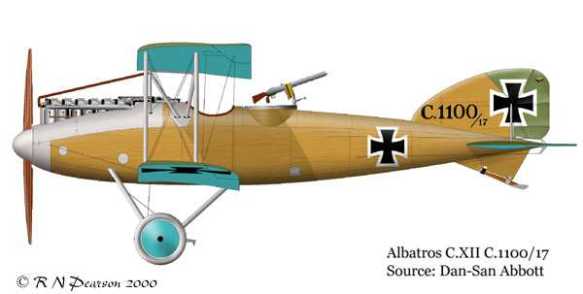The long-serving Albatros C class was among the finest and most adaptable reconnaissance aircraft of World War I. They combined good performance and reliability into an aesthetically pleasing airframe.
The Albatros family of two-seat reconnaissance aircraft grew out of the prewar unarmed Bseries. The new C versions, introduced in 1915, were armed, more strongly built, and capable of defensive maneuvering. Successive models tended to be better armed and better powered, and in 1917 the trend culminated in the introduction of the C X model. This version mounted the new 260-horsepower Mercedes D IVa engine that gave it greater speed and altitude than previous versions. It capped a tendency in the reconnaissance family to incorporate more and more features of the famous D series of fighters. It also sported lengthened wings that housed flush-mounted radiators and double ailerons. The C X displayed good high-altitude performance and the two-man crew carried its own oxygen supply aloft along with a wireless radio. The plane commenced field service in the summer of 1917 and proved entirely successful as a photo platform and artillery spotter. A total of 330 machines were constructed, and they served with distinction to war’s end.
In time Albatros followed up with an improved model of the C X, the C XII. From an aesthetic standpoint, this was the most pleasing aircraft of the entire series. The C XII was the first reconnaissance machine to directly incorporate the trademark elliptical fuselage cross-section of the famous D-series fighters. It also employed an enlarged, curved tailfin strongly reminiscent of the scouts, along with a triangular ventral fin attached to the tail skid. However, the motor, wing, and landing gear of the previous aircraft were retained. The overall effect of the new machine was sleek and elegant. However, for all its refinement, the C XII boasted little improvement over the C X in terms of performance. It was nevertheless deployed in some numbers and served alongside earlier versions until the Armistice.
Specifications (C.XII)
General characteristics
Crew: two, pilot and observer
Length: 8.84 m (29 ft 0 in)
Wingspan: 14.12 m (46 ft 4 in)
Height: 3.25 m (10 ft 8 in)
Wing area: 42.7 m² (459 ft²)
Empty weight: 580 kg (1,280 lb)
Gross weight: 1,061 kg (2,340 lb)
Powerplant: 1 × Mercedes D.IVa, 190 kW (260 hp)
Performance
Maximum speed: 178 km/h (110 mph)
Endurance: 4 hours 20 min
Service ceiling: 5,640 m (18,500 ft)
Rate of climb: 4.2 m/s (820 ft/min)
Armament
1 × forward-firing 7.92 mm (.312 in) Spandau LMG 08/15 machine gun
1 × 7.92 mm (.312 in) Parabellum MG14 machine gun for observer
